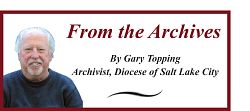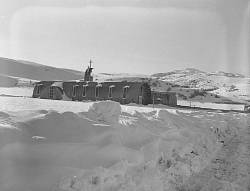Diary of Huntsville Trappist monk describes move from Kentucky
Friday, Mar. 11, 2016
World War II, with its violence on an unprecedented scale, was a hugely traumatic experience for all who lived through it. Catholics were not exempt from the trauma, and many began thinking, “If this the best secular civilization can do, maybe we had better start looking for something else.”
That “something else” for some was the Order of Cistercians of Strict Observance, or the Trappists.
During and immediately after the war the monastery of Our Lady of Gethsemane in Kentucky swelled with new vocations to several times its planned capacity, and it became necessary to create satellite houses to handle the overflow. One of those, as announced in Chapter on June 29, 1947, was to be erected in Huntsville, Utah.
The following account, from the monastery archives, is of the move from Kentucky to Utah of 34 pioneer monks, based on an anonymous diary written by one of those monks. I am indebted to my friends John Sillito, for transcribing the diary, and Mike O’Brien, for calling it to my attention.
One of the vows taken by monks is one of stability, meaning that they agree to remain in the house where they have made their profession. Thus, moving almost three dozen monks most of the way across the continent was not something they were very good at. Their move was clumsy, inefficient and even comical. It was also heartrending: Although many of the monks were still novices, they had gotten so used to community life that saying farewell to brother monks whom they knew they would never see again taxed their vows of obedience:
“Last farewells. The hearts of many, perhaps of all, were bleeding. But then, the hearts that bleed are the sweetest hearts of all,” reads a diary entry.
To effect separation from the other passengers on the train, the monks chartered their own Pullman car, which proved to be not big enough:
“There were not enough berths for all, ergo, Fr. Sebastian proceeded to sleep on the floor, saying that the carpet was softer than his couch at Gethsemane,” the diary states.
To avoid the dining car, the monks had provided their own food – boxes of bananas, some five hundred buns, oranges, cheese, hot chocolate and salt. But at their first stop, Louisville, that monastic diet sustained a severe disruption when someone donated 25 or 30 dozen doughnuts!
The trip was not all hardship and disruptions:
“Many could not sleep. Fr. Mauritius said that all night he lay looking out the window and enjoying the beautiful moonlight reflected in the rivers and streams. He had no opportunity for such sights for many years, so it was quite a treat for him to behold the soft splendor of Our Lady’s mantle, the moon,” according to the diary.
While crossing the Colorado Rockies, “the writer of this little account was so enraptured by the unfolding grandeur of God’s beauty that he forgot to write down anything.”
Eventually the monks arrived in Huntsville, according to the diarist’s precise reckoning, “2 days and 18 hours 57 ½ minutes after leaving Gethsemane.”
They were met by a delegation of nuns from St. Benedict’s Hospital in Ogden bearing food for them: milk, oranges, apples, cookies and, perhaps most welcome of all, more doughnuts!
The most pressing chore in those early days was erection of dismantled military barracks until the Quonset huts that became their permanent lodging could be assembled, but Trappists in rural Utah were such an exotic sight that the hundreds of visitors who kept dropping by made it difficult for the monks to work. On one occasion a couple of ebullient ladies grabbed Fr. Mauritius by each arm and someone snapped a photograph of their embrace.
“If that ever gets published …” the priest lamented.
Nor were those the only trials for the monks. Summer thundershowers made it imperative to get roofs on the buildings, and the roofers they hired “were a brutal group of men. The job was finished in a couple of days and their language was as hot as the tar they put on the roof,” the writer of the diary recorded.
Eventually, of course, the buildings were completed, the fertile land was brought under cultivation, and the monks settled into the life of work and prayer that have made them such a blessing and spiritual foundation for Utah Catholics.
As we see the Abbey of Our Lady of the Holy Trinity in Huntsville passing into its last days, it is well that we look back and reflect on the role it has played in Utah history.
For questions, comments or to report inaccuracies on the website, please CLICK HERE.
© Copyright 2024 The Diocese of Salt Lake City. All rights reserved.
© Copyright 2024 The Diocese of Salt Lake City. All rights reserved.



Stay Connected With Us